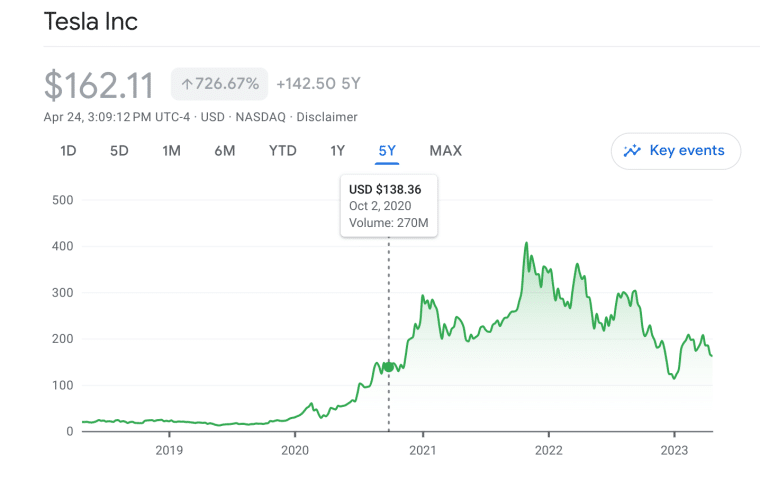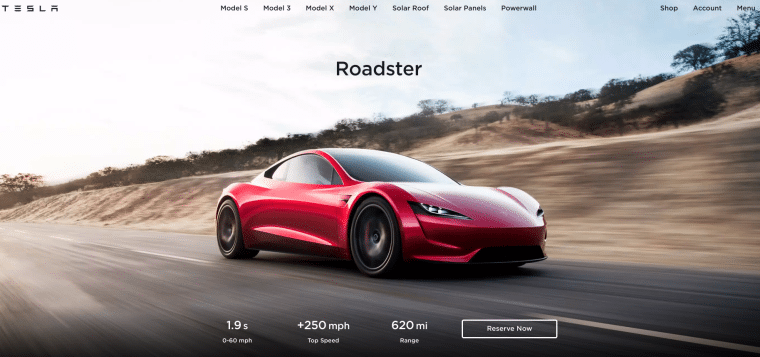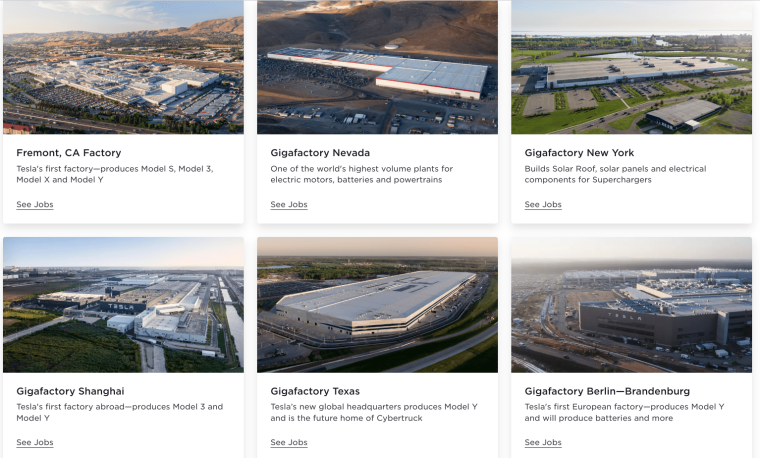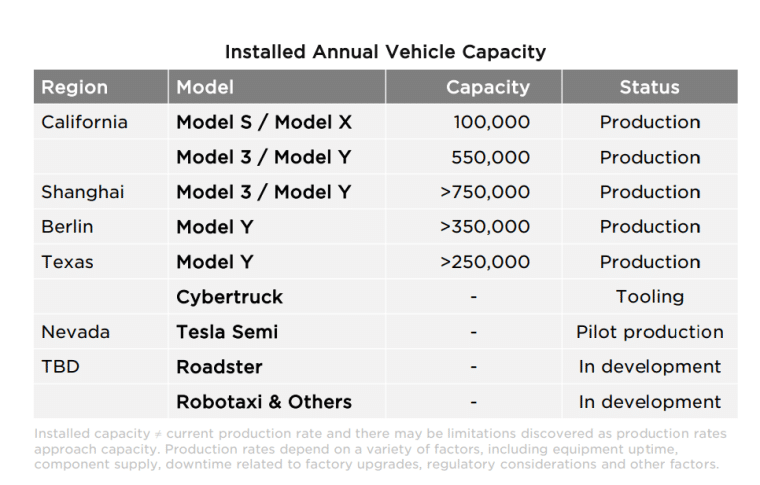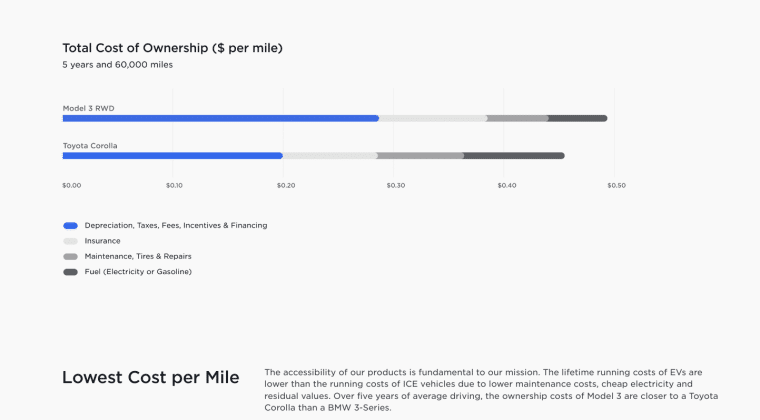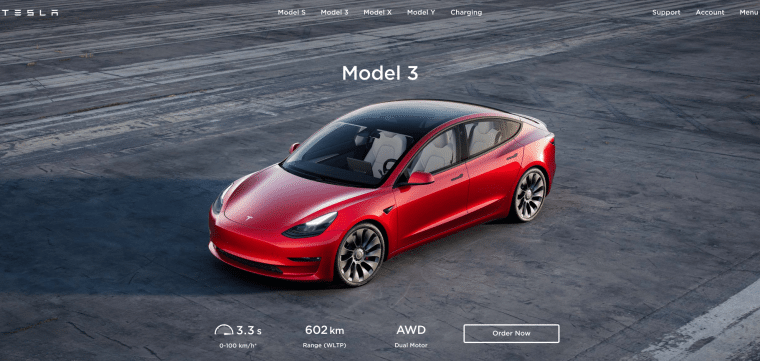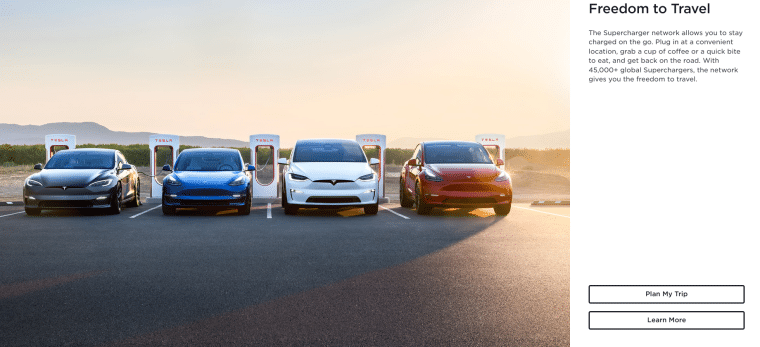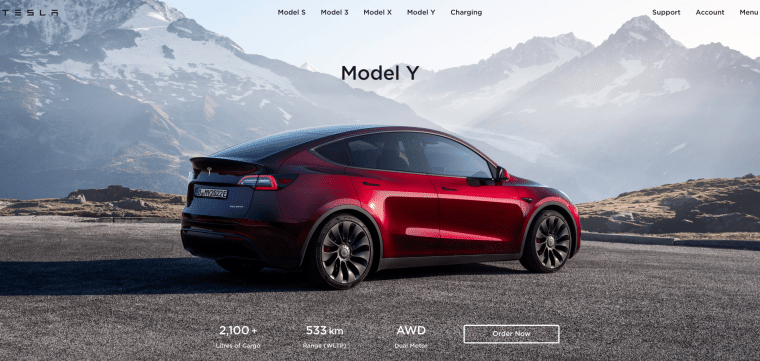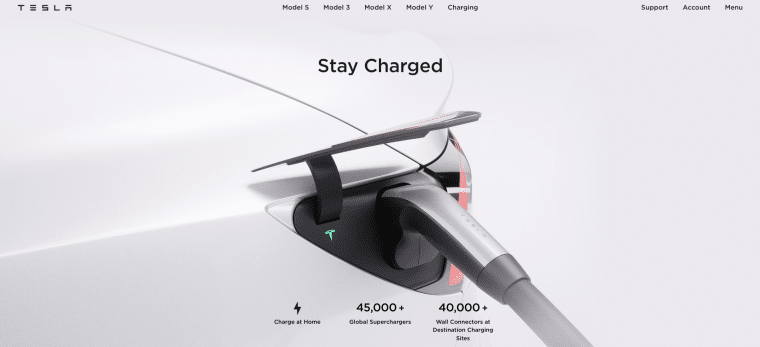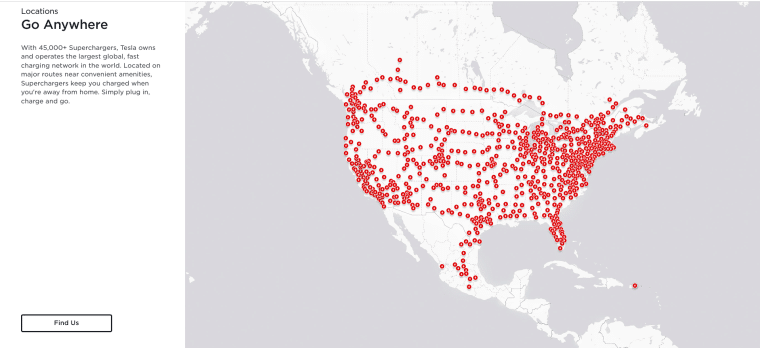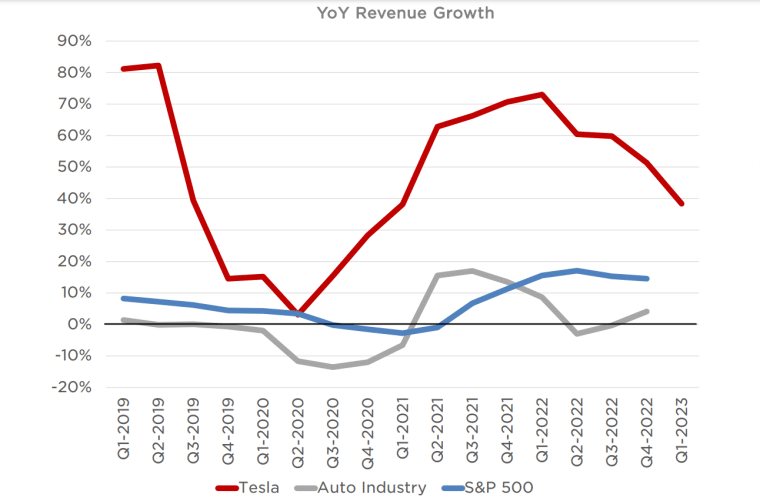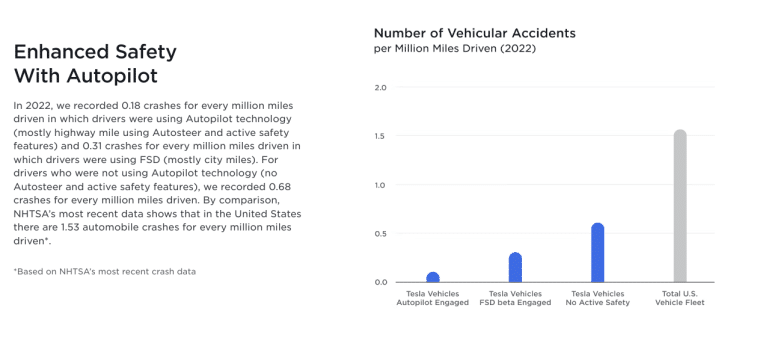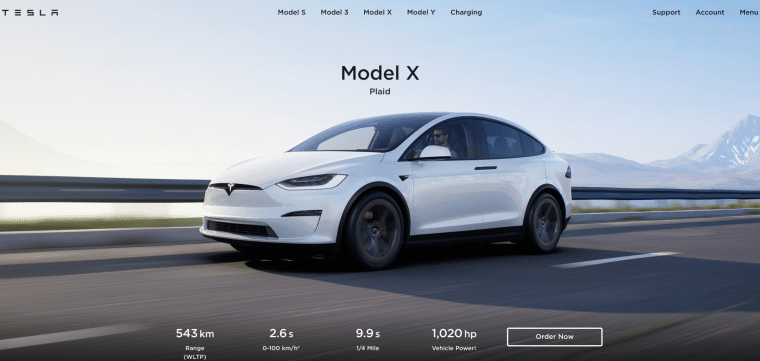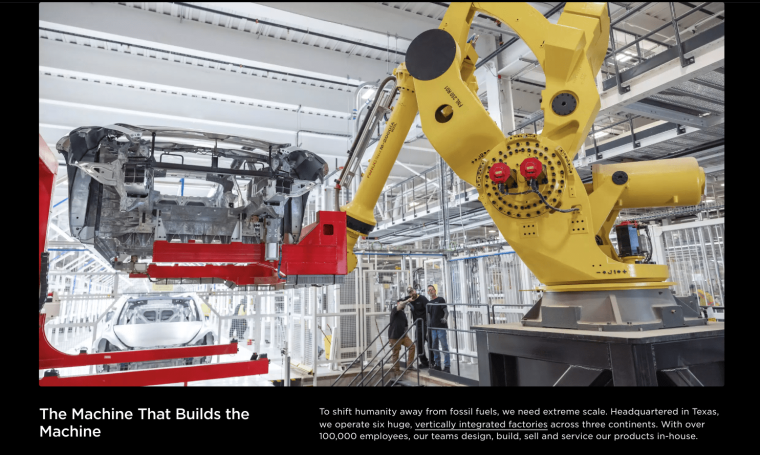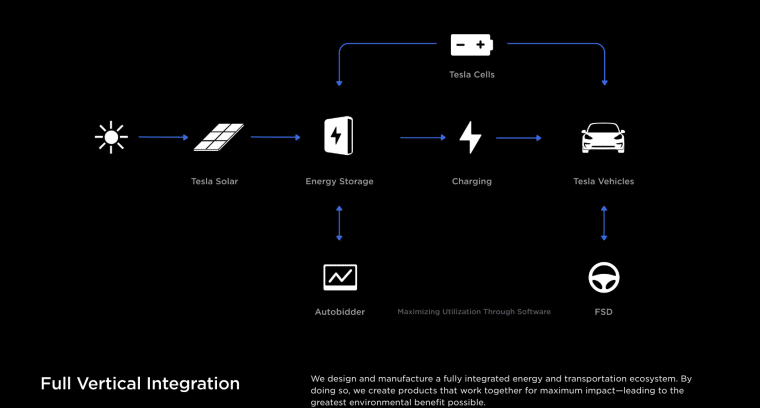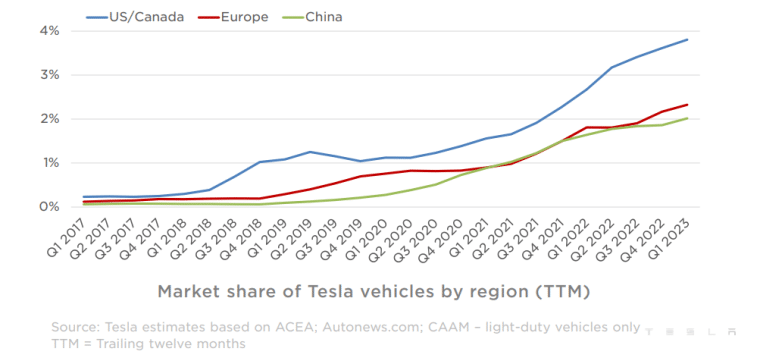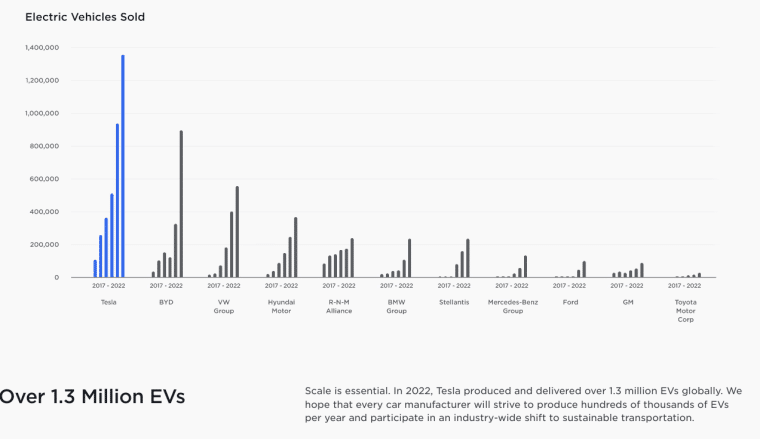Staying true to its core mission, Tesla continues to accelerate the world’s transition to sustainable energy with electric cars, solar, and integrated renewable energy solutions for homes and businesses. With Elon Musk in the driver’s seat, Tesla has raced to global dominance, overtaking well-established brands to become one of the most valuable automakers in 2023.
From Tesla’s history to revenue statistics and more, this guide explores all you need to know about the world’s most popular automaker. Read on to discover over 50 electrifying Tesla stats.
Tesla, Inc. is an American company that manufactures and sells electric vehicles, power storage, and photovoltaic systems. The company’s name is a tribute to physicist and inventor Nikola Tesla and its core mission is to accelerate the transition to sustainable energy. Tesla has achieved impressive growth and success to become one of the world’s most valuable automakers. Below is a timeline of its rise to global market dominance: Tesla raised $7.5 million in Series A funding in 2004. In 2004, Tesla raised $7.5 million in Series A funding. Elon Musk invested $6.5 million and became the largest shareholder. Tesla raised $13 million in Series B venture capital funding in February 2006. Elon Musk led Tesla’s Series B venture capital funding round of $13 million, which added Valor Equity Partners to the funding team. In May 2006, Tesla raised $40 million in a third round of investing. In a third funding round co-led by Elon Musk, Tesla received investment from Google co-founders Sergey Brin and Larry Page, and former eBay President Jeff Skoll. Tesla raised a further $45 million in a fourth round of investing. Concluded in May 2007, this investment round brought Tesla’s total private financing investment to over $105 million. Tesla secured a $465 million loan from the United States Department of Energy. The US Department of Energy loan was to fund the production of its Model S and develop a manufacturing facility in Fremont, California, to produce battery packs, electric motors, and other powertrain components. Tesla became a public company in 2010 through an initial public offering (IPO) on the NASDAQ. Tesla issued 13.3 million shares of common stock at a price of $17.00 per share and raised a total of $226 million. This was higher than the expected range of $14-$16 per share, with shares surging 41% to close at a new high of $23.89. Tesla reached a market cap of $206 billion in July 2020. The EV giant surpassed Toyota’s $202 billion market cap to become the world’s most valuable automaker by market cap in July 2020. In August 2020, shares crossed the $2,000 per share mark. Ahead of its first stock split, shares surged to an all-time high to earn Tesla a valuation bigger than Walmart. It also became the first automaker to hit a share price that high. By December 2020, Tesla’s market cap had exceeded the next nine largest automakers combined. Tesla’s market cap reached $1 trillion in October 2021. This made Tesla the fifth company to do so in U.S. history. Tesla stock went on to reach a peak of $381.59 per share in November. Tesla’s stock plunged 65% in 2022 due to market conditions and weakened demand. This overall decline came after a 3-for-1 stock split on August 25, 2022, Musk’s purchase of Twitter, and other turbulent market conditions. By March 2023, Tesla stock was up 48% at $207.46 per share. Between 2015 and 2022, Tesla acquired several businesses to secure its position as an industry leader. Tesla has made 9 acquisitions and 2 investments. The automaker has invested in multiple sectors, such as energy storage tech, autonomous vehicles, electric vehicles, and more. Tesla has acquired: As of April 23, 2023, Tesla has a market cap of $523.2 billion. This makes Tesla the most valuable automaker and the 9th most valuable company in 2023. Tesla’s production spans three continents. While headquartered in Palo Alto, United States, Tesla’s manufacturing locations, which service over 40 markets span three continents: Each factory is built from the ground up to run on renewable energy, helping to further reduce the environmental impact of electric vehicle ownership. Tesla is planning to build a new factory in Monterrey, Mexico. The announcement, made on March 1, 2023, comes as Tesla looks to expand its operations and reduce costs. A new factory in Mexico would be Tesla’s third factory outside of the US following plants in Shanghai, China, and Berlin, Germany. Tesla produced 440,808 vehicles in Q1 of 2023. In the first quarter of 2023, Tesla produced over 440,000 vehicles, a 44% year-on-year increase. This record number of vehicles was due to ongoing ramp ups at its Austin and Berlin plants. Energy storage deployments increased by 360% year on year. In Q1 of 2023, energy storage deployments increased to 3.9 GW, representing a massive 360% increase from 2022. This is due to the ongoing ramp of the 40 GWh Megapack factory in Lathrop, California. A second 40 GWh Megafactory is planned for Shanghai, with construction starting later in 2023. Solar deployments increased by 40% year on year. Solar deployments increased by 40% year on year to 67 MW in the first quarter of 2023. However, this is down from 100 MW in the last quarter of 2022, mainly because of volatile weather and other factors. Additionally, the global solar industry has been affected by supply chain challenges. Tesla expects to produce more than 1.8 million vehicles in 2023. Tesla has produced over 3 million car models since 2008. In 2022, vehicle deliveries grew 40% year on year to 1.31 million while production grew 47% year on year to 1.37 million. According to Elon Musk, the EV giant expects to produce 1.8 million, possibly an upside of 2 million vehicles in 2023. Production of the Cybertuck is scheduled to begin in Q3 2023. In January 2023, Elon Musk announced that production of the anticipated Cybertruck, which has been delayed for two years, is scheduled for production in the last quarter of 2023 and mass production in 2024. The company later confirmed this in a Quarterly update released on the 19th of April 2023. Giga Berlin achieved a production rate of 5000 Model Ys per week in Q1 2023. At the current rate of production, Tesla is on track to exceed its 500,000 car per year limit at the factory. Consequently, Tesla submitted an application to Germany’s environmental agency to increase its limit to 1 million vehicles per year on 16 March 2023. Tesla is close to a preliminary deal to set up a factory in Indonesia. In January 2023, Tesla announced it was close to a preliminary deal to set up a factory in Indonesia. By capitalizing on Indonesia’s reserves of key battery metals, the plant is set to produce up to 1 million cars a year. Research by Hedges and Company, a digital marketing firm for automakers, revealed that: The average household income of a Tesla Model X owner in 2022 is $146,623 per year. This is up from $143,177 in 2018. The average household income of a Tesla Model S owner in 2022 is $151,096 per year. That’s down slightly from $153,313 in 2018. The average Tesla Model S or Model X owner is just under 54 years old. The median age of a Model X owner is 52 years old and the median age of a Model S owner is 54, confirming that Tesla owners belong to an older, more established demographic. Tesla Model S, 3, and X drivers typically have annual household incomes that average $151,096, $133,879, and $146,623, respectively. The median household income in the US is $70,784, according to 2021 data from the US Census Bureau. Tesla drivers have higher incomes and tend to be individuals with household incomes of over $100,000 per year. 77%, 71%, and 84% of Model S, X, and 3 owners identify as male, respectively. This means that 23%, 29%, and 16% of Model S, X, and 3s respectively, are female. The gender split confirms that Teslas are more popular with men. 87% of individuals who own Models S, X, and 3 identify as Caucasian. According to a study by Jerry, an insurance agency, most Tesla owners in the US identify as Caucasian. 8% identify as Hispanic and 5% represent all other ethnicities. A third of Tesla drivers have a master’s degree or doctoral degree. The Jerry study also found that Tesla drivers occupy positions such as engineer, manager of operations, and software engineer. 78% of Tesla owners would buy one again. According to a Consumer Reports survey, 78% of owners would buy one again. This is just behind Porsche (83%) and Genesis (80%), but higher than other mega brands like Lexus and Toyota (both with 72%). Tesla has a network of over 70 Owners Clubs across the US and UK. According to Tesla, the Tesla Owners Club is a community of owners and enthusiasts committed to advancing its mission to accelerate the world’s transition to sustainable energy. Tesla Owners Clubs are located in the US, Canada, and countries throughout Europe and Asia Pacific. Tesla has 764 retail stores, galleries, and service centers. This makes Tesla the first automaker in the United States to sell cars directly to consumers. In January 2023, Tesla slashed global prices of its electric vehicles by as much as 20%. To boost demand and put pressure on rivals, Tesla lowered prices across key markets such as the United States, Europe, the Middle East, and Africa in January 2023. The reduced prices made more vehicles eligible for the U.S. subsidy of $7,500 per car, consequently driving up demand in the US and in other locations. Tesla delivered 422,875 vehicles in Q1 of 2023. In the first quarter of 2023, Tesla delivered over 420,000 vehicles, representing a year-on-year increase of 36%. This was spurred by greater production efficiency and increased demand. Tesla’s cumulative sales have surpassed 4 million vehicles as of 22 April 2023. By focusing heavily on ramping up production of the Model 3 and Model Y and delivering over 400,000 vehicles in Q1 2023, Tesla’s sales have crossed the 4 million mark. The Model Y was the bestselling non-pick-up in the US for Q1 2023. Due to increased demand and production capacity, the Model Y overtook competitors such as Toyota and Ford to become the best-selling non-pick-up in the US in the first quarter of 2023. Tesla’s Model Y was also the best-selling vehicle in Europe in Q1 2023. The Model Y and Model 3 ranked as European best-sellers in 2022. The trend continues with the Model Y being the best-selling vehicle in Europe for the first quarter of 2023. Tesla surpassed Audi in global sales for the first time in Q1 of 2023. By selling 422,875 cars globally, Tesla beat Audi’s total of 415,700. Automotive sales accounted for 82.5% of Tesla’s revenue in 2022. Automotive sales are Tesla’s biggest growth driver, accounting for about 82.5% of revenue in 2022. Automotive sales revenues have also increased by 52% year-on-year. In 2022, Tesla’s US EV sales increased by 54.5% year on year. Tesla’s largest market is the US and in 2022, the EV giant remained the market leader with a market share of over 50%. Battery EV (BEV) sales grew by almost 70% year-on-year to account for more than 80% of all EV sales in 2022. In January 2023, Tesla China sales increased by 18%. Tesla sold 66,051 vehicles from its Shanghai Plant. This is an increase of 18% from the 55,796 vehicles shipped in December 2022 and a 10% jump overall from those shipped in January 2022. Overall, China accounts for about 40% of Tesla’s total sales. Tesla sales in Europe have seen a 50% growth rate. Tesla’s sales in Europe grew faster than any other automaker in February 2023. Data from the European Automobile Manufacturers’ Association (ACEA) shows that registrations of Tesla EVs in the European Union increased from 12,860 in February 2022 to 19,249 units in February 2023. Tesla spends $0 in advertising per car sold. Unlike other major automakers, Tesla relies on word of mouth as opposed to mass media campaigns. This allows Tesla to divert more funds to critical areas such as safety and R&D. Tesla Model 3 and Model Y global sales increased by 36.8% between 2021 and 2022. According to Tesla, global sales of the Tesla Model 3 sedan and Tesla Model Y SUV went up 36% from 911,208 in 2021 to 1,247,146 in 2022. *Tesla reports its Model 3 and Y as a single figure and does not disclose the split in sales between models. Tesla Model S and Model X global sales increased by 167.5% between 2021 and 2022. Tesla reported that global sales of the Model S large sedan and Model X large SUV increased 167.5% from 24,964 in 2021 to 66,705 in 2022. Tesla’s most popular models are the Model 3 and Y The Model 3 remains the all-time bestselling plug-in electric car worldwide and in June 2021 became the first electric car to sell approximately 1 million units globally. Tesla sold 760,000 Model Ys in 2022, an 88,7% increase from the previous year. As of January 2023, Tesla has over 45,000 superchargers worldwide. There has been a 54% increase in superchargers worldwide between 2021 and 2022. As of April 2023, a majority of these stations are in the US and China. A Tesla supercharger supplies up to 200 miles of battery life in just 15 minutes of charge. Standard wall connectors, in comparison, supply up to 44 miles of range per hour of charge. Tesla is now supplying 1.5 million supercharging sessions every week. In the US, Tesla dominates DC fast-charging installations. In the first quarter of 2023, Tesla installed more stations in the US than all other charging companies combined. The company plans to open up its network to non-Tesla EVs, and by doing so, will gain access to $7.5 billion in EV funding from new US legislation under the Biden administration. From 2018 to 2022, Tesla’s revenue had a 5-year CAGR of 47.3%. Tesla experienced steady revenue growth through model additions and increased production across its manufacturing locations. In 2020, Tesla’s annual revenue was $31.54 billion. Total revenue of $31.54 billion in 2020 marked a 28.31% increase from 2019. 2020 was also the first year that Tesla reported a net income. In 2021, revenue went up to $53.82 billion, which is a 70.67% increase from 2020. Tesla’s revenue grew to $81.46 billion in 2022. Total revenue of $81.46 billion in 2022 marked a 51% increase from 2021. More than $71 billion of the company’s revenue in 2022 was generated from Tesla’s automotive segment, which includes the design, manufacturing, and sales of electric vehicles. Tesla’s total Q1 2023 revenue is up 24% at $23.33 billion. Total revenues are up 24% from Q1 2022. However, revenue from the first quarter of 2023 shows a slight drop from Q4 2022’s revenue of $24.32 billion. Automotive Q1 2023 revenue increased by 18% to $19.96 billion. Automotive, Tesla’s core segment, reported revenue of $19.96 billion in the first quarter of 2023. This is up 18% from Q1 2022. Tesla’s energy and storage Q1 2023 revenue increased by 148% to $1.53 billion. Energy generation and storage revenue went up from $616 million in Q1 2022 to $1.53 billion in Q1 2023, representing a massive increase of 148%. Services and Other Q1 2023 revenue increased by 44% to $1.84 billion. Services and other revenue increased 44% from $1.28 billion in Q1 2022 to $1.84 billion in Q1 2023. Both revenue and gross profit from services and other reached an all-time high in the first quarter of 2023. This is due to the growth of used vehicle sales and supercharging, which continue to grow as Tesla opens up its network to non-Tesla vehicles. Tesla’s operating income decreased to $2.7 billion in Q1 2023. As a result of a lower year-on-year average selling price (ASP), higher operating expenses, and production costs, Tesla’s operating income decreased to $2.7 billion in Q1 2023, resulting in an 11.4% operating margin. As of January 2023, over 9 billion miles have been driven with Autopilot engaged. Tesla uses billions of miles of real-world data from its global fleet to understand the different ways accidents happen. It then develops features that help Tesla drivers avoid accidents. Between 2012 and 2021, there has been approximately one Tesla vehicle fire for every 210 million miles traveled. By comparison, data from the National Fire Protection Association (NFPA) and the U.S. Department of Transportation shows that there is a vehicle fire for every 19 million miles traveled in the US. Driving a Tesla on Autopilot is up to ten times safer than driving the average vehicle. Even without Autopilot engaged, Teslas are still 2.5 times safer than the average vehicle. In Q4 2022, Tesla recorded one crash for every 4.85 million miles driven. One crash every 4.85 million miles represented drivers using Tesla’s Autopilot technology. Drivers not using the technology had one crash every 1.40 million miles driven. By comparison, there’s one crash every 652,000 miles in the US. The Model S received a 5-star Euro NCAP rating and 5 stars in every NHTSA category. In 2014, The Model S was one of the few vehicles to achieve a 5-star Euro NCAP rating and 5 stars in every National Highway Traffic Safety Administration (NHTSA) category. In 2022, the Euro NCAP awarded the updated Model S a 5-star safety rating. In 2019, Tesla’s Model 3 won the highest safety honor. This was issued by the Insurance Institute for Highway Safety (IIHS) and was the first time Tesla received such an award. The Model 3 was asserted to be one of the safest cars in the world, achieving stellar performance in all six IIHS crash tests. The agency’s data shows that vehicle occupants are less likely to get seriously injured in certain types of crashes when in a Model 3 than in any other car. Model S, Model 3, Model X, and Model Y have the lowest overall probability of injury. Active safety features come standard with all Tesla vehicles made after September 2014 for an added layer of safety. As of October 2018, all of Tesla’s models have the best safety of any vehicle ever tested by the NHTSA. Tesla’s Model X was named the safest SUV in the EV market in 2015. The Model X was the first SUV ever to earn 5-star safety ratings in every category and sub-category in the NHTSA’s tests in 2015. Tesla plans to launch Full Self Drive in 2023. On April 19, 2023, Elon Musk announced that Tesla would likely launch Full Self Drive (FSD) in 2023. The software is predicted to be a major profit driver for the company amidst price cuts and margin pressure. FSD software costs $15,000, which is close to a third of the starting price of the base Model Y in the US. Full Self Drive Beta users have driven 150 million cumulative miles as of April 2023. The mass collection of diverse datasets is essential for Tesla to achieve scalable autonomy. With beta users having driven 150 million cumulative miles as of April 2023, Tesla’s level of data collection is unprecedented in the industry. Tesla’s R&D spending increased to almost $3.1 billion in 2022. Tesla has emerged as the top EV manufacturer in the US because of its high level of investment in research and development. Between December 2021 and December 2022, R&D expenses increased by $482 million, or 19%. The increase was to support Tesla’s growing product range and proprietary technologies. R&D spending as a percentage of revenue decreased from 5% to 4% in the year ending December 31, 2022. Although R&D expenses have decreased as a proportion of total revenues, Tesla is still able to support its expanding product roadmap and technologies. Tesla spends $2,984 per car sold on R&D. This figure is almost triple the amount spent by other automakers. In 2016, Tesla became the world’s first vertically-integrated sustainable energy company with the acquisition of SolarCity. Tesla became the world’s first vertically-integrated sustainable energy company by acquiring SolarCity, a leading provider of solar power systems in the US. As of April 2023, all six of Tesla’s manufacturing plants are sustainable and vertically integrated. Tesla has 3,304 patents globally. These patents belong to 986 unique patent families. Of those 3,304 patents, 2,147 patents are active and 580 patents cover electrical machinery and transportation. On June 12, 2014, Tesla announced that it would not initiate patent lawsuits against anyone who, in good faith, made use of its technology. As of April 2023, this patent pledge is still active. Tesla is one of the leading EV companies globally. Tesla has consistently positioned itself as a market leader in clean technology and a force to be reckoned with in the auto industry. In 2020, Tesla was ranked as the leading electric vehicle brand worldwide. Tesla’s European market share is up 2.4% in April 2023. Although Tesla faces competition from automakers in Europe, it continues to make inroads against European brands like Dacia, Renault, and Toyota. Tesla’s China market share is up 10% in April 2023. Tesla’s share of the total EV market in China, including battery-electric vehicles and plug-in hybrids, is around 10%, up 3% from 2022. Tesla’s biggest competitor, BYD, has a market share of about 45%, up from 30% in 2022. Tesla became the sixth fastest-growing brand worldwide in 2023. According to Statista, Tesla became the sixth fastest-growing brand in the world in 2023, with a 44% brand value growth rate. This is behind Chinese competitor BYD, which takes the top spot with a growth rate of 57%. Tesla has sold more electric cars in the US than all its competitors combined. Although competitors like General Motors, Ford, and Volkswagen have entered the EV market, Tesla maintains its stronghold in the US market. Giga Shanghai retail sales surged 36% in Q1 2023. Tesla’s January 2023 price cuts stimulated demand by 36% to 25,686 vehicles, meanwhile, major Chinese Competitor BYD’s sales fell by 45% in Q1 2023. Tesla is the most valuable car brand in 2023. With a brand value of almost $76 billion, up from 42 billion in 2022, Tesla overtook brands such as Toyota and Mercedes-Benz to secure the top spot. According to Brand Finance, this makes Tesla the most valuable auto brand. It’s also the first time that a brand not manufacturing internal combustion engines has topped the global rankings. Tesla vehicles had the best battery ranges in 2022. The 2021 Tesla Model 3 and Model S have some of the longest battery ranges. This comes as the automaker ramped up its R&D efforts to enhance battery quality and range for its electric vehicles. As of March 2023, Tesla faces stiff competition from brands like Lucid, BMW, Mercedes Benz, and Polestar. Tesla’s market share has slipped from 70.5% in 2021 to 63.5% in 2023 Though a major player in the US, Tesla’s hold is slipping as more affordable EV options enter the market.Tesla – Key Stats
Tesla Timeline and History
Tesla Investment Statistics
Tesla Production Statistics
Fremont Factory North America Gigafactory Nevada North America Gigafactory New York North America Gigafactory Texas North America Gigafactory Shanghai Asia Gigafactory Berlin-Brandenburg Europe Tesla EV Models Years of Production Roadster 2008 to 2012 Model S 2012 – present Model X 2015 – present Model 3 2017 – present Model Y 2020 – present Semi Truck 2022 – present (Pilot Production) Cybertruck Planned for Q3 2023 / 2024 Second Generation Roadster Planned for 2023 Tesla Ownership Statistics
Tesla Sales Statistics
Year Total Tesla Global Sales Percentage Increase From the Previous Year Models 2022 1,313,851 40% Model S, Model X, Model 3, Model Y 2021 936,172 87.4% Model S, Model X, Model 3, Model Y 2020 499,550 36% Model S, Model X, Model 3, Model Y 2019 367,500 50% Model S, Model X, Model 3 2018 245,240 138% Model S, Model X, Model 3 2017 103,120 35% Model S, Model X, Model 3 2016 76,230 51% Model S, Model X 2015 50,557 60% Model S 2014 31,655 41% Model S 2013 22,477 625% Model S 2012 3100 0% Model S, Roadster (2008 to 2012) Tesla Supercharger Statistics
Tesla Revenue Statistics
Year Tesla’s Total Revenue in Billions of US Dollars 2022 81.642 2021 53.823 2020 31,536 2019 24,578 2018 21,461 Tesla Safety Statistics
Tesla Research and Development Statistics
Tesla vs Competitor Statistics
Fun Facts on Tesla
FAQs
How much is the cheapest Tesla?
How long does a Tesla Battery last?
References

